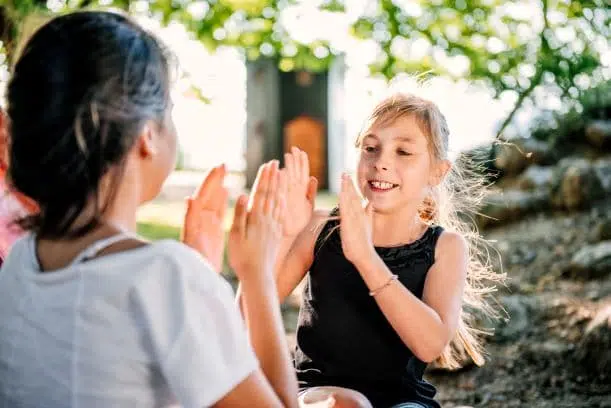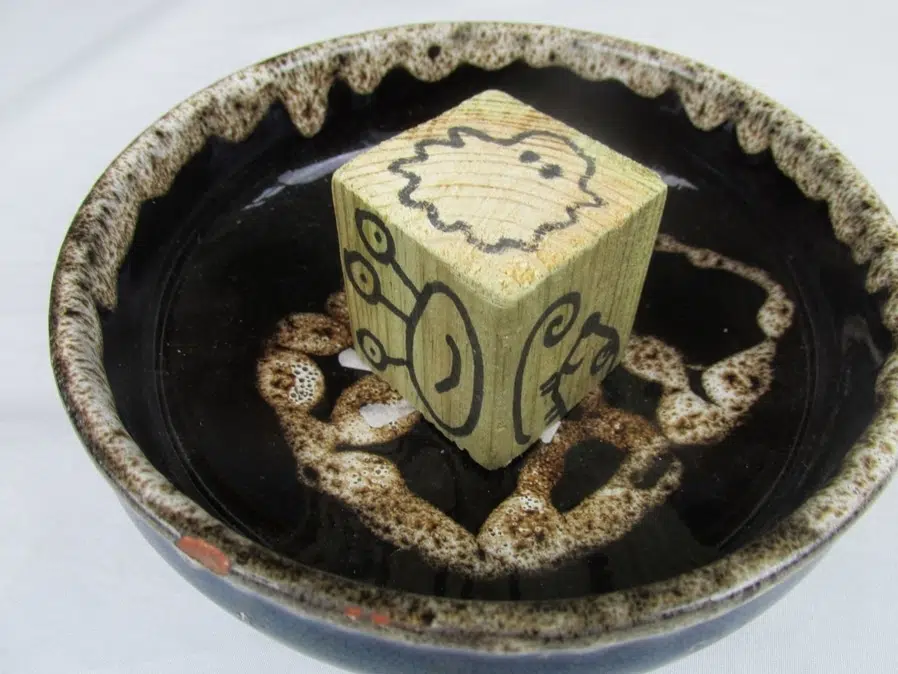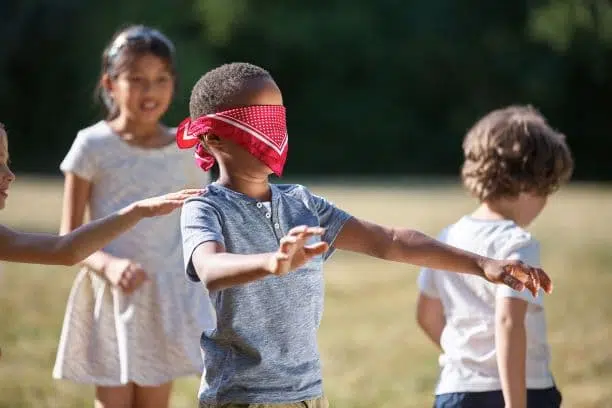Partners games are exactly what they sound – a game that a child plays with a partner. Just two children can play them, or they can be played by a whole class split up into partners.
Partners games can be really beneficial. They are so simple to do and break up any structured learning time with fun activities that children enjoy.
But what are the best partner games for kids? Here are the ones I have whittled down from a long list. They are the cream of the crop:
- ‘And Then’ Story
- Mirror Image
- Counting Forwards/Backwards
- Counting 10s/5s/2s
- Staring Contest
- Rock Paper Scissors
- Make The Number
- Yes/No Game
- Think Pair Share
- Copy The Face
- Pat-A-Cake Pat-A-Cake
- A Sailor Went To Sea, Sea, Sea
- Can’t Laugh Challenge
- Interviews
- Blind Man’s Buff
- Number Write
Partners games teach many skills like eye-contact, turn-taking, cooperation, listening skills, social skills, and teamwork. On top of these, you can teach all sorts of other skills, such as maths, phonics, literacy, science, and many more.
These fun games can be used in teaching the entire curriculum.
The games I am focusing on are all fantastic for children aged 3 to 7, but many can be used with older children as well.
OK, here are the games:

1. ‘And Then’ Story
Let’s kick off with a fantastic storytelling activity.
This is realistically for children from about the age of 4 upwards (it will be trickier before this age).
The idea is that a pair of children sit facing each other.
One child is going to go first. They quite simply start a story. It can be on any theme they like – for example, ‘One day a frog went into the forest.’
Then the next child speaks. They are going to start their sentence ‘And then…’ and in such a way they will carry on the story. (For example, ‘And then a witch flew down.’)
Keep going like this: one sentence at a time, with the next child carrying it on by saying ‘and then.’
Top Tips – Model it first, either with another willing adult, or at least a child with good communication skills. To make it easier, start them off with the opening line and they go from there.
You could get them to pass an object between them after every sentence if you like. Something like a pebble would be great for this.
For many more storytelling strategies check out this article.
2. Mirror Image
This is a fun game that introduces reflection and symmetry to an extent, as well as being great for eye contact and teamwork. (To find out the best 10 symmetry activities for children then take a look at this.)
One child is the leader and the other child copies. Have a few goes then swap roles.
The leader is going to do some sort of movement, and the other child is going to copy. For example, they might lift their arm, and the other child lifts their arm. They wave, and the other child waves.
Children naturally will do this like a mirror, as in if one child waves their right arm, the other child waves their left.
Other actions they could do are things like moving their head from side to side, all sorts of different arm movements, clapping, patting their knees, and any other ideas they can come up with.
3. Counting Forwards/Backwards
A bit of math now. This game is fantastic for practicing rote counting. To find out what rote counting is (and the best ways to teach it) take a look at this.
The easiest way to do it is to start from 1, but you can extend it in multiple ways.
Basically, in its easiest form, one child will say ‘one’, then the other says ‘two’. The first child says ‘three’ and so on. Keep counting for as long as they can.
Other ways to try this game are:
- Starting from 0
- Counting on from a given number, e.g. 6
- Counting in silly voices (such as a witch, or an alien)
- Counting backwards from 5 or 10
- Counting backwards from a given number, e.g. 7.

4. Count in 10s/2s/5s
A bit of a harder one now for children from probably about 6 upwards (although some 5-year-olds will be able to do it too).
Count in different times tables, e.g. 2s, 5s, or 10s (though it could really be anything).
Again, different ways to extend it include:
- Count in 10s or 2s but start at a given number (e.g. 30)
- Count backwards
- Count backwards from a given number
- Count beyond the range of the times table that they know (e.g. beyond 12 lots of the number)
To find out lots more rote counting games you can try, then check this out.
5. Staring Contest
The old classic staring contest! This is great for all children aged 3 to 7.
This is the ultimate game for eye-contact, which is so important for children in these screen-obsessed times.
You simply sit staring at each other, and the child that holds off from blinking the longest is the champion.
You can also do the laughing version: you stare and the winner is the one that doesn’t laugh. Hours of fun.
6. Rock Paper Scissors
Another old classic game from the repertoire.
I’m sure you know how to play this one, but just in case – two children sit opposite each other.
They have one hand in a fist. They ‘beat’ this into their other cupped hand as they say ‘1,2,3…’ and on the fourth downwards motion they make either a rock (fist), paper (straight palm), or scissors (two fingers stretched out).
Rock beats scissors, and loses to paper.
Scissors beat paper, and paper loses to rock.
Paper beats rock, and loses to scissors.
Keep your score! You can play best of 3 or best of 5 (or more).
Top Tip – For older children of probably about 7 upwards, there is a harder version of the game called ‘Rock Paper Scissors Spock Lizard’. In this ‘Spock’ is signified by a Vulcan split-fingered salute, and ‘lizard’ by a kind of sock puppet hand.
Take a deep breath, because here are the rules…
Spock beats scissors and rock, but loses to paper and lizard.
Lizard beats spock and paper, but loses to rock and scissors.
Rock beats scissors and lizard, but loses to paper and spock.
Paper beats rock and spock, but loses to scissors and lizard.
Scissors beat paper and lizard, but loses to rock and spock.
Good luck getting your head around that one!
7. Make The Number
This is a game for children of about 5 upwards.
Two players face each other, and the adult gives them a number. They are going to try to make the number by sharing it between them by holding out their fingers.
So, for example, if the number is ‘8’, then one child might be holding out ‘5’ fingers and the other child will try to find ‘3’.
This takes lots of thinking and time in reality. The big rule is that one child can’t make the number by themselves. You have to share!
Excellent for practical number bonds, developing problem solving skills, and team building activities. It is also great for one-to-one correspondence (check out the ultimate guide to 1 to 1 correspondence here).
8. Think Pair Share
This is a fantastic cooperative learning structure and team building activity that can be used for children from about the age of four upwards.
The idea is that when you ask a question of a whole group of children, the kids turn to their partners and discuss what they think.
Then some of the pairs of children feed back their answers.
This will generate a lot more thought around the questions you ask, and also is good for their independence – developing what they know as well as how they think at the same time.
9. Can’t Laugh Challenge
This is a great game for some good old-fashioned fun, as well as requiring eye-contact and creativity as well.
Many children have seen this game on Youtube, Tik Tok, or something similar to that.
One child basically sits there and is not allowed to speak. The other one is going to try to make them laugh.
They can use any silly comments, foolish faces, funny noises – anything they can think of. A good team building game and excellent for confidence.
When that child has succeeded in making them laugh, they switch roles.
Top Tips – Comedy is a hard thing to explain to some children, and there will be some that just don’t know what to do. Others will just find everything hilarious. Like all these games, there is no easy quick fix that will work perfectly for everyone, but playing it a few times will help children learn from others.
10. Copy The Face
One of the most exciting partner and team building games, Copy The Face is a quick game that is good for eye contact, and understanding of human emotion. Great for children three and upwards.
One child is going to be the leader to start with, and the other is going to copy. The leader makes different facial expressions – happy, sad, cross, shocked etc. The other one tries to copy.
Then after they have had a go at that way round, get them to swap roles.
If you want to make it easier, then the adult could lead the children by telling them the emotion to try, such as ‘let’s all do a cross face’. This is the simpler version of the game.
11. A Sailor Went To Sea Sea Sea
Now let’s take a look at a classic clapping game.
There are many of these clapping games, and they are fantastic for coordination, gross motor skills, crossing the mid-line, and many other skills like eye contact and teamwork.
A Sailor Went To Sea Sea Sea is a song coordinated hand clapping game.
The song goes like this:
A sailor went to sea sea sea,
To see what he could see see see.
But all that he could see see see,
Was the bottom of the deep blue sea sea sea.
The hand-clapping element is probably best demonstrated by this short 12-second video of it in action:
For older children, there is a harder version, that goes like this:
1st Verse – A sailor went to sea sea sea…
2nd Verse – A sailor went to chop chop chop
To see what he could chop chop chop….(and carry on)
3rd Verse – A sailor went to knee knee knee
4th Verse – A sailor went to sea chop knee
To see what he could see chop knee
You can check out how it is done in this live demo:
12. Pat-A-Cake Pat-A-Cake
This is another classic clapping game, great for all the same skills that I listed in the Sailor Went To Sea game.
The lyrics normally go something like this:
Pat-a-cake, pat-a-cake,
Baker’s man,
Bake me a cake as fast as you can,
Roll it and prick it
And mark it with ‘B’,
And put it in the oven for baby and me.
There is a great demo video here (the actual demo starts at 30 seconds in):
A fantastic activity for even very young children, who all love the topic of cakes!
13. Yes/No Game
Yes/No game is one of the best partner games and team building exercises as well.
This is slightly trickier than some of these other pairs games, and I probably wouldn’t try this with children under the age of 5.
This game is well known on many kids’ youtube channels, so many children will know how to do this. It is also a popular playground game.
You simply talk to each other and try to make the other person say ‘yes’ or ‘no’. You can use any tactics you want.
The main one is to think of questions that the other person cannot avoid answering without saying ‘yes’ or ‘no’. A very amusing game to watch when it is working well.
Again it is great for communication, listening and creativity.
14. Interviews
Interviews are a fantastic way of developing communication and getting children listening and interacting with each other.
One child will be asking the questions in this game, and the other child will be answering. Then, after a while, they swap roles.
A great way to do it is to link to a book.
The child getting interviewed can pretend to be a character from a story. For example, they might be the Evil Queen from Snow White.
The interviewer might ask anything, ‘Where do you live?’ ‘What have you been doing?’ ‘What did your mirror say today?’ Any of these kinds of things. This really helps the children to get into the characters and their motivations.
Another way to do it is just to ask the child questions about their own lives. ‘What food do you like? What do you like to play?’ All that kind of thing.
For older children, the interviewee could pretend to be a famous person from history. They might be Abraham Lincoln for example. Ask them about what they have done, and what they hope to do.
15. Blind Man’s Buff – Pairs
I think this is a classic Victorian game, and one that can be played in many different ways.
This is a great partners game that involves movement, and is best done outside a wide space.
Children are in pairs. One child closes their eyes. The other is going to guide them.
The child with their eyes closed is at the front, and the other walks behind them. The child at the back tries to direct the other to a certain point, for example, to a tree, or a bench. This is great for positional language – things like go forward, left, right, back, and all that kind of thing. (Check out 14 fantastic positional language games here).
Be aware of safety! Encourage them to walk slowly, and it is best done in a reasonably deserted space so they don’t bang into others.

16. Number Write
This is another quite simple game, that is good for turn-taking, and also for learning how to write numbers in a sequence.
Have a whiteboard and a pen per pair of children, or you could have a piece of paper and a pencil between them.
Basically one of the children starts. They are going to write the number ‘1’.
Then they pass the board or paper to the other child, and they are going to write the number ‘2’.
They keep passing the board or paperback between themselves as they keep on adding numbers in order. They can refer to a number line if they are having problems.
This game can be extended in the following ways:
- Write the numbers backwards starting at 10 or 20
- Write in 2s or 10s
- Write as far as you can go!
Final Thoughts
Partners games get children truly engaged, and they are also fantastic at developing social skills in a fun way.
Pretty much any form of adult-led learning can be broken up with partners game.
Good luck if you try any of them out, and if you’ve found this useful, then why not take a look at one of these articles:
